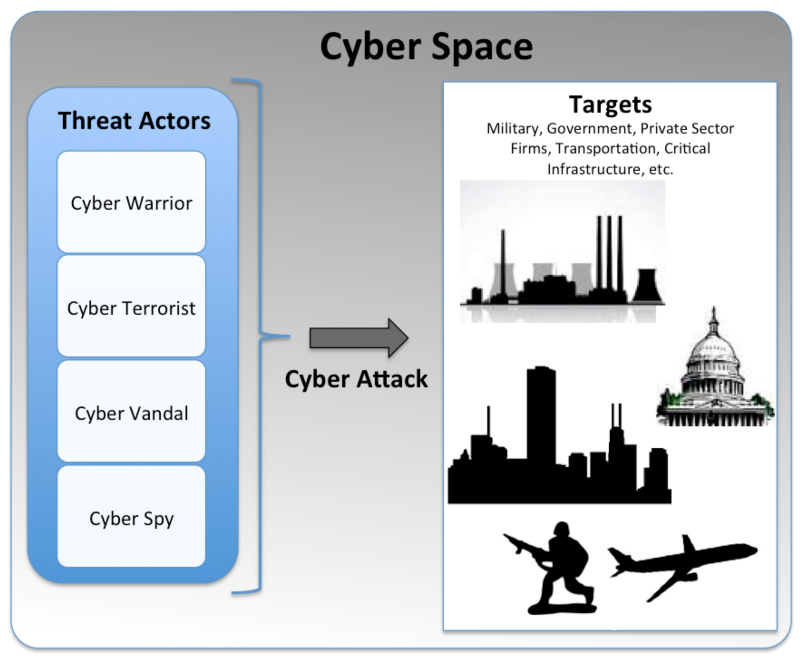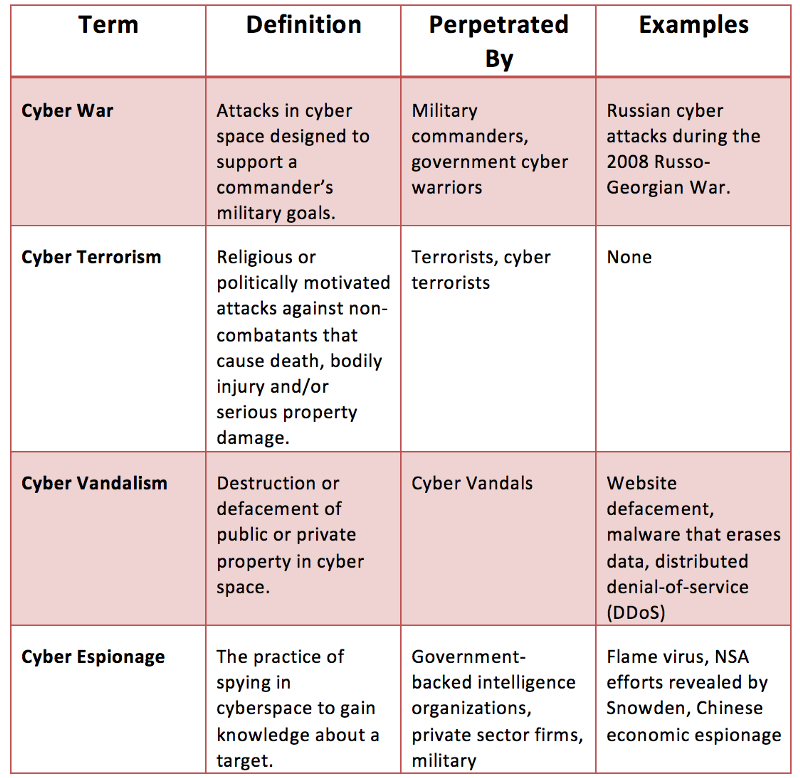A Beginner’s Guide to Cyber War, Cyber Terrorism and Cyber Espionage
Photo by Rafael Rex Felisilda on Unsplash
Tune in to just about any cable talk show or Sunday morning news program and you are likely to hear the terms “cyber war,” “cyber terrorism,” and “cyber espionage” bandied about in tones of grave solemnity, depicting some obscure but imminent danger that threatens our nation, our corporate enterprises, or even our own personal liberties. Stroll through the halls of a vendor expo at a security conference, and you will hear the same terms in the same tones, only here they are used to frighten you into believing your information is unsafe without the numerous products or services available for purchase.
The industry lacks a rubric of clear and standardized definitions of what constitutes cyber war, cyber terrorism, cyber espionage and cyber vandalism. Because of this, it’s becoming increasingly difficult for those of us in the profession to cut through the noise and truly understand risk. For example, on one hand, we have politicians and pundits declaring that the US is at cyber war with North Korea, and on the other hand President Obama declared the unprecedented Sony hack was vandalism. Who’s right?
The issue is exacerbated by the fact that such terms are often used interchangeably and without much regard to their real-world equivalents.
The objective of this article is to find and provide a common language to help security managers wade through the politicking and marketing hype and get to what really matters.
The state of the world always has been and always will be one of constant conflict, and technological progress has extended this contention from the physical realm into the network of interconnected telecommunications equipment known as cyberspace. If one thinks of private-sector firms, government institutions, the military, criminals, terrorists, vandals, and spies as actors, cyberspace is their theater of operations. Each of these actors may have varying goals, but they are all interwoven, operating within the same medium. What separates these actors and accounts for the different definitions in the “cyber” terms are their ideologies, objectives, and methods.
The best way to forge an understanding of the differences in terms is to look at the conventional definitions of certain words and simply apply them to cyberspace. For example, traditional, kinetic warfare has a clear definition that is difficult to dispute: a conflict between two or more governments or militaries that includes death, property destruction, and collateral damage as an objective. Cyber warfare, therefore, uses the same principles of goals, actors, and methods that one can examine against a cyber attack to ascertain the gravity of the situation.
Let’s examine two of the most common phrases used, “cyberspace” and “cyber attack” and get to the root of what they really mean.
The realm in which all of this takes place in cyberspace, and as previously stated, can be thought of as a theater of operation.
The Department of Defense defines cyberspace as:
A domain characterized by the use of electronics and the electromagnetic spectrum to store, modify, and exchange data via networked systems and associated physical infrastructures.
A good analogy to help people understand cyberspace is to draw a parallel to your physical space. You are a person and you are somewhere; perhaps an office, house, or at the car wash reading this on your iPhone. This is your environment, your space. You have objects around you that you interact with: a car, a sofa, a TV, a building. You are an actor in this space and there are other actors around you; most have good intentions, and some have bad intentions. At any point, someone in this environment can act against you or act against an object in the environment.
Cyberspace is essentially the same: it is an environment in which you operate. Instead of physically “being” somewhere, you are using computing equipment to interact over a network and connect to other resources that give you information. Instead of “objects,” like a car or a sofa, you have email, websites, games, and databases.
And just like real life, most people you interact with are benign but some are malicious. In the physical space, a vandal can pick up a spray paint can and tag your car. In cyberspace, a vandal can replace your website’s home page with a web defacement. This is called a cyber attack and the vandal is a cyber vandal.
The graphic below illustrates the overall cyberspace environment, threat actors, and possible targets. To help you conceptualize this, think about the same paradigm, but in a physical space. Take away the word “cyber” and you have warriors, terrorists, vandals, and spies that attack targets.

The actual attack may look the same or similar coming from different threat actors, but goals, ideology and motivation is what sets them apart.
An excellent definition of an attack that occurs in cyberspace comes from James Clapper, former Director of National Intelligence:
A non-kinetic offensive operation intended to create physical effects or to manipulate, disrupt, or delete data.
This definition is intentionally very broad. It does not attempt to attribute political ideologies, motivations, resources, affiliations, or objectives. It simply states the characteristics and outcome.
Cyber attacks of varying degrees of destruction occur daily from a variety of actors and for many different reasons, but some high-profile attacks are the recent rash of retail data breaches, the Sony Pictures Entertainment hack, website vandalism, and distributed denial-of-service (DDoS) attacks.
The groundwork is set for what is a cyber attack and the environment, cyberspace, in which they are launched and experienced by the victim. This is the first step in dispelling myths to truly understand risk and what is possible (and not possible) when it comes to protecting your firm and the nation.
Now the real fun begins — we’ll dissect the four most commonly confused terms: “cyber war,” cyber terrorism,” “cyber vandalism” and “cyber espionage” and provide a common lexicon. The objective is to dispel myths and, by establishing common understanding, provide a way for managers to cut to the chase and understand risk without all the FUD. The graph below shows the four terms and attributes at a glance.

Now let’s dig into each individual definition and examine the fundamentals.
Cyber warfare
Cyber warfare is the most misused terms in this list. The U.S. Strategic Command’s Cyber Warfare Lexicon defines cyber warfare as:
Creation of effects in and through cyberspace in support of a combatant commander’s military objectives, to ensure friendly forces freedom of action in cyberspace while denying adversaries these same freedoms.
There are very clear definitions as to what constitutes war (or an action that is an act of war), and the cyber version is, in essence, no different. Cyber warfare is an action, or series of actions, by a military commander or government-sponsored cyber warriors that furthers his or her objectives, while disallowing an enemy to achieve theirs. Military commanders typically belong to a nation-state or a well-funded, overt and organized insurgency group (as opposed to covertrebels, organized crime rings, etc.). Acting overtly in cyberspace means you are not trying to hide who you are — the cyber version of regular, uniformed forces versus irregular forces.
On Dec. 21, 2014, President Obama stated that the Sony hack was an act of cyber vandalism perpetuated by North Korea, and not an act of war. This statement was criticized by politicians, security experts and other members of the public, but one must look at what constitutes an act of war before a rush to judgment is made. Let’s assume for the sake of this analysis that North Korea did perpetrate the attack (although this is disputed by many). Was the act part of a military maneuver, directed by a commander, with the purpose of denying the enemy (the United States) freedom of action while allowing maneuverability on his end? No. The objective was to embarrass a private-sector firm and degrade or deny computing services. In short, Obama is right — it’s clearly not part of a military operation. It’s on the extreme end of vandalism, but that’s all it is.
The subsequent threats of physical violence to moviegoers if they viewed “The Interview” has never been attributed to those who carried out the cyber attack, and frankly, any moron with Internet access can make the same threats.
Few public examples exist of true, overt cyber warfare. Stories circulate that the U.S., Israel, Russia, China and others have engaged in cyber war at some point, but the accounts either use a looser definition of cyber war, or are anecdotal and are not reported on by a reputable news source.
One of the strongest candidates for a real example of cyber war occurred during the 2008 Russo-Georgian War.
Georgia, Ossetia, Russia and Abkhazia (en)” by Ssolbergj (CC BY-SA 3.0)
Russia and Georgia engaged in armed conflict over two breakaway republics, South Ossetia and Abkhazia — both located in Georgia. Russia backed the separatists and eventually launched a military campaign. In the days and weeks leading up to Russia’s direct military intervention, hackers originating from within Russia attacked key Georgian information assets. Internet connectivity was down for extended periods of time and official government websites were hacked or completely under the attacker’s control. In addition, internal communications and news outlets were severely disrupted. All of the above would hamper the ability of Georgian military commanders to coordinate defenses during the initial Russian land attack.
Cyber terrorism
No one can agree on the appropriate definition of terrorism, and as such, the definition of cyber terrorism is even murkier. Ron Dick, director of the National Infrastructure Protection Center, defines cyber terrorism as
…a criminal act perpetrated through computers resulting in violence, death and/or destruction, and creating terror for the purpose of coercing a government to change its policies.
Many have argued that cyber terrorism does not exist because “cyberspace” is an abstract construct, whereas terror in a shopping mall is a very real, concrete situation in the physical world that can lead to bodily harm for those present. Cyber terrorism, as a term, has been used (and misused) so many times to describe attacks, it has almost lost the gravitas its real-world counterpart maintains.
According to US Code, Title 22, Chapter 38 § 2656f, terrorism is:
…premeditated, politically motivated violence perpetrated against noncombatant targets by subnational groups or clandestine agents.
In order to be a true cyber terrorist attack, the outcome must include violence toward non-combatants and result in large-scale damage or financial harm. Furthermore, it can often be difficult to attribute motivations, goals, and affiliations to cyber defilement, just as in the physical world, which makes attribution and labels difficult in the cases of both traditional terrorism and cyber-terrorism.
There are no known examples of true cyber terrorism. It certainly could happen — it just hasn’t happened yet.
Cyber vandalism
There is not an “official” US government definition of cyber vandalism, and definitions elsewhere are sparse. To paraphrase Justice Stewart, it’s not easy to describe, but you will know it when you see it.
The definition of “vandalism” from Merriam-Webster is “willful or malicious destruction or defacement of public or private property.”
Cyber vandals usually perpetrate an attack for personal enjoyment or to increase their stature within a group, club, or organization. They also act very overtly, wishing to leave a calling card so the victim and others know exactly who did it — think of wayward subway taggers, and the concept is about the same. Some common methods are website defacement, denial-of-service attacks, forced system outages, and data destruction.
Examples are numerous:
-
Anonymous DDoS attacks of various targets in 2011–2012
-
Lizard Squad DDoS attacks and website defacements in 2014
-
For now, the Sony Pictures Entertainment hack, unless attribution can be made to a military operation under the auspices of a nation-state, which is unlikely.
Cyber espionage
Much of what the public, politicians, or security vendors attribute to “cyber terrorism” or “cyber war” is actually cyber espionage, a real and quantifiable type of cyber attack that offers plenty of legitimate examples. An eloquent definition comes from James Clapper, former Director of National Intelligence:
…intrusions into networks to access sensitive diplomatic, military, or economic
There have been several high-profile cases in which hackers, working for or sanctioned by the Chinese government, infiltrated US companies, including Google and The New York Times, with the intention of stealing corporate secrets from companies that operate in sectors in which China lags behind. These are examples of corporate or economic espionage, and there are many more players — not just China.
Cyber spies also work in a manner similar to the methods used by moles and snoops since the times of ancient royal courts; they are employed by government agencies to further the political goals of those organizations. Many examples exist, from propaganda campaigns to malware that has been specifically targeted against an adversary’s computing equipment.
Examples:
-
The Flame virus, a very sophisticated malware package that records through a PC’s microphones, takes screenshots, eavesdrops on Skype conversations, and sniffs network traffic. Iran and other Middle East countries were targeted until the malware was discovered and made public. The United States is suspected as the perpetrator.
-
The Snowden documents revealed many eavesdropping and espionage programs perpetrated against both US citizens and adversaries abroad by the NSA. The programs, too numerous to name here, are broad and use a wide variety of methods and technologies.
Conclusion
The capabilities and scope of cyber attacks are just now starting to become understood by the public at large — in many cases, quite some time after an attack has taken place. Regardless of the sector in which you are responsible for security, whether you work at a military installation or a private-sector firm, a common language and lexicon must be established so we can effectively communicate security issues with each other and with law enforcement, without the anxiety, uncertainty and doubt that is perpetuated by politicians and security vendors.
The article was originally published at CSO Online as a two-part series (Part 1 and Part 2) and updated in 2022.
*** This is a Security Bloggers Network syndicated blog from Blog - Tony Martin-Vegue authored by Tony MartinVegue. Read the original post at: https://www.tonym-v.com/blog/2015/04/15/cyber-what%E2%80%8A-%E2%80%8Auntangling-all-the-different-cyber-terms





